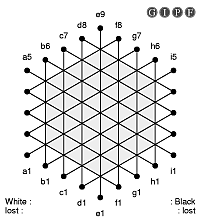|
The best way to better to get better at GIPF is,
of course, to play a lot. At times you just know that your play
is improving, but it will also happen that you have the impression
that you don't make progress any more. When that is the case, it
may sometimes help to have a look at GIPF in another way, e.g. by
trying to solve some of the Puzzles
or by having a look (replaying) one of the games in the Archives.
Another thing that can be helpful is to make a drawing of a situation
that you find interesting. When you are playing a game of GIPF and
suddenly you find yourself confronted with a peculiar situation,
draw a diagram with the position of the pieces. When the game is
finished - or some other time - you can have a look at it again
and go deeper into it if you like, either by reconstructing the
situation on the board or by using GF1.
|
